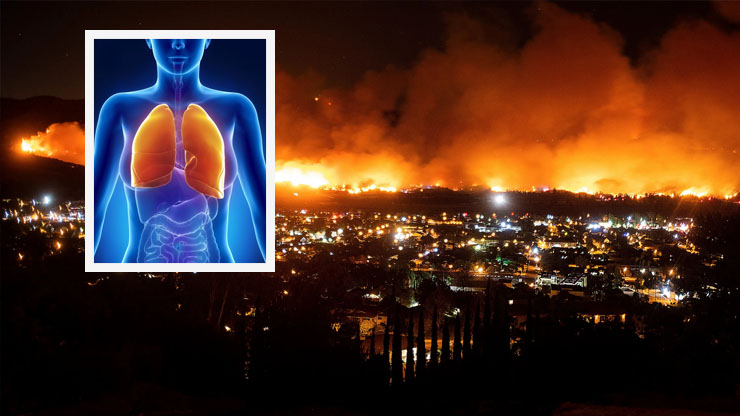California's 2020 wildfire season looks like something straight out of a Sci-Fi blockbuster. This year's wildfires have already incinerated millions of acres, and they're not showing signs of letting up. As more vegetation burns, massive amounts of smoke and ash are continuously released into the atmosphere, creating a blanket of toxic air.
The American Lung Association, in response to the decline in air quality, has issued certain protocols to protect residents' lung health. Here's a breakdown of what you and your loved ones should do to guard your lung health.
Wear a Functional Mask
On June 18, Governor Gavin Newsom made face masks mandatory amid soaring cases of COVID-19 cases. Most Californians duly complied, with some residents utilizing ordinary dust masks or cloth coverings. However, experts at the ALA argue against these coverings and insist on using N95, N100, or R100 masks. Why?
While dust masks and cloth coverings help to keep you from spreading disease to others, they are inefficient at filtering out tiny particulate matter in the air. These small particles are responsible for inducing symptoms such as coughing, sneezing, difficulty in breathing, and a runny nose. Specialized masks, such as N95 or R100 masks, filter out the small particles and significantly reduce the chances of inhaling particulate matter. However, in the wake of the prevailing COVID-19 pandemic, these specialized masks may be in short supply, and they should only be used when going outside.
Avoid the Outdoors If You Can
California first issued stay-at-home orders back in March as a way of curbing the spread of COVID-19. This time around, state authorities are urging people to stay indoors to avoid inhaling toxic air. Essential activities like going to the store or medical check-ups should be done in as little time as possible. Also, if you must exercise, make use of your indoor living space.
Make Use of Your Home's Air Conditioning System
Your home's heating, ventilation, and air conditioning (HVAC) system is designed to keep your living space cool while also circulating indoor air. With summer temperature still high and air quality poor, your home's HVAC system is an invaluable resource. Set the system on the recirculation setting to keep indoor air circulating while avoiding sucking outdoor air.
Remember to shut the intake using the damper to keep toxic air from entering your home. Upgrade to high-efficiency particulate air (HEPA) filters to provide added protection from the toxins. If your home lacks a comprehensive HVAC system, you could source for a portable HEPA-certified air purifier to provide some much-needed protection.
Air-Seal Your Home
Air-sealing is a technique used during home construction to limit moisture migration, improve energy efficiency, and restrict the amount of outdoor air entering the building. The main aim of air-sealing is to limit the loss of heat during winter. However, it can also serve to curb the entry of smoke. A professional contractor comes in and builds envelopes to fill cracks and gaps where air can enter your home.
If you don't have the budget for a professional contractor, there's a DIY trick that might help. Take a couple of towels, dampen them, and place them under doors or around windows. As elementary as this technique sounds, it's an excellent way to keep out the soot-filled air.
Keep Your Car Windows Rolled Up
Local officials could issue an evacuation notice at any time, making cars an important asset to have. Whenever you and your loved ones are riding along in a car, ensure all the windows are closed. Keep the air conditioner running and adjust the settings to re-circulate for better airflow.
Seek Shelter as Quickly as Possible
If you've had to evacuate, you'll have to find temporary residence elsewhere. If you have family or friends who can take you in, well and good. If you have nowhere to go, the American Red Cross response team has established temporary evacuation points where people can receive support and aid. The worst scenario right now is being outdoors, continuously exposed to the toxic smoke and ash.
Avoid Burning Anything Indoors or Vacuuming
With wildfires come frequent power blackouts. You might be tempted to light a few candles, but don't do it. As they burn, candles use up precious oxygen and will ultimately lower your indoor air quality.
Vacuuming is also a no-go zone. As you vacuum, you stir up any particulate matter that's already settled in your home. The more air disturbance you cause, the worse your indoor air quality becomes.
In Conclusion
Nature experts warn that the California wildfires haven't reached their full destructive potential yet. For California residents, those predictions are a portent of the calamity that lies ahead. Winds off the Pacific coastline are expected to clear up some of the smoke in the region, but that's largely dependent on the pattern of the fires. In the meantime, do all that you can to stay safe and keep healthy.
Resources:
cdc.gov/nceh/features/wildfires/index.html
latimes.com/projects/california-fires-damage-climate-change-analysis/
sacbee.com/news/california/fires/article245721940.html
redcross.org/about-us/news-and-events/news/2020/red-cross-response-to-california-wildfires.html
laheatingairconditioning.com/post/how-to-use-your-hvac-after-a-wildfire


